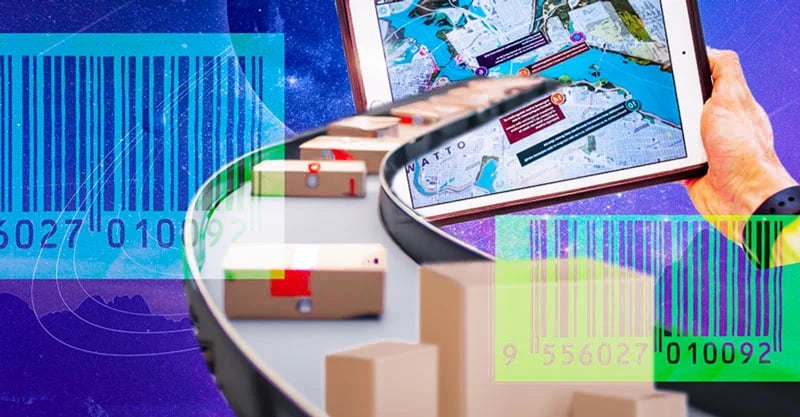Supply chains are in focus in an age of value-driven delivery, heightened consumer expectation, a volatile global economic landscape, and the pressing need for sustainable business models globally. The need for transparency within supply chains has emerged out of these factors.
The importance of supply chain traceability
Supply chain traceability seeks to identify and track every aspect of manufacturing, distribution, and the chain of custody of a product’s journey. Supply chain traceability promotes business resilience and better management of partner ecosystems. It boosts sustainability, compliance, and transparency, helping consumers make informed buying decisions and holding brands accountable. Ultimately, supply chain traceability can be a mechanism for managing risks and gaining a competitive advantage in the market. Its applicability spans various sectors, including automotive, chemicals & materials, healthcare & pharmaceutical, food & drink, and retail.
The ITONICS Supply Chain Traceability report provides an overview of supply chain traceability, presents some of the key trends and technologies influencing its future, and serves as a springboard for further exploration. It is interlinked with the ITONICS Innovation OS, where you can find a collection of analyst-curated insights related to supply chain traceability.
Explore the trends and technologies most pertinent to supply chain traceability. Use this collection to help build and refine your foresight intelligence, identify opportunities for innovation, and future-proof your supply chain.
Download the supply chain traceability report to explore more insights from ITONICS.
The case for supply chain traceability
The matrix below provides an overview of the potential challenges and opportunities associated with supply chain traceability. These implications for innovation highlight how transparency and the ability to monitor and act on supply chain information are critical for globally-oriented businesses.
|
Challenges |
Opportunities |
|
|
Transparency |
Limited insight into supply chains creates uncertainty that can impact brand perception and destroy value. |
Embedding full operational transparency into business models enables strategic evolution. |
|
Risk management |
Lack of visibility can lead to multiple risk failures in supply chains, resulting in potential disruptions like product recalls. |
Traceability can improve the ability to identify and respond to risks pre-emptively, while balancing strategic investments into potential opportunities. |
|
Brand reputation |
Lack of supply chain insights can lead to customer mistrust and damage brand reputation. |
Providing supply chain visibility can positively impact customer purchasing decisions and brand reputation, leading to increased brand equity. |
|
Value creation |
Lack of investment or over-investment in traceability can hinder value creation through misaligned financial resources. |
Traceability can add value across the supply chain and enables sustainable growth through optimized vendor ecosystems and trusted customer relationships. |
|
Supply chain resilience |
Opaque supply chains are more vulnerable to market disruptions and lack the flexibility to respond timeously and effectively. |
Traceability provides organizations with data to make informed decisions, project growth, and plan for potential disruptions. |
|
Sustainable sourcing |
An inability to verify sustainability claims can result in perceived greenwashing or noncompliance with regulators. |
The ability to verify sustainable and ethical sourcing builds customer loyalty and promotes ESG compliance. |
|
Minimizing waste |
Lack of insight into supply chain sources enables unabated waste of resources with little accountability. |
Better insight into supply chain sources can help to minimize the waste of limited resources such as raw materials, water, and energy. |
|
Regulation & compliance |
Harmful ingredients, additives, and chemicals in supply chains can cause widespread damage to customers and the environment. |
Thorough compliance reporting provides evidence to regulators and confidence to investors and customers. |
Industry snapshots: Supply chain traceability in automotive and chemicals & materials industry
Supply chain traceability impacts a variety of industries that move goods globally. Our supply chain traceability report takes a look at the following industries and conducts a deep dive of the forces shaping the future of these sectors:
- Automotive
- Chemicals & Materials
- Healthcare & Pharmaceutical
- Food & Drink
Below is a brief snapshot of how supply chain traceability impacts the automotive and chemical & materials industries and how the trends and technologies in the ITONICS Innovation OS impact these industries. Download the entire Supply Chain Traceability report here to gain a full view of the insights impacting these industries.
Automotive
As a significant contributor to carbon emissions, the automotive industry is working hard to clean up its act, with the electrification of the industry at the center. The success of electric vehicle production has much riding on it as the industry balances advancing technologies and sustainability imperatives. As a result, automakers bear intense scrutiny across their automotive supply chains. Greater industry collaboration and transparent blockchain technologies are features of shifting automotive supply chains that seek to ensure traceability, robustness, and resilience as the foundation for the automotive industry’s future.
Some of the forces shaping the future of supply chain traceability in the automotive industry include the following:
1. Electric vehicle-driven demand for critical minerals
Growing competition in the EV industry contributed to global sales of more than 6.5 million units in 2021. While Tesla was the first to release a long-range, high-performance EV, many leading automakers continue to manufacture rival products, notably in China, where EVs are gaining market share due to widely established charging infrastructure. Electromobility provides a broader perspective on the disruptive aspects of the EV revolution on the automotive industry and mobility in general.
The EV revolution has significant implications for mineral-abundant regions, many of which are already highly reliant on the global automotive industry as a source of demand. The increasing demand for critical minerals like cobalt and lithium used in Next-Gen Batteries has led to stiff competition. There are also broad-scale systemic impacts on local mining communities and heightened geopolitical wrangling, where the extraction of exhaustible natural resources fosters instability. The ability to trace these critical minerals from their origin and verify the conditions in which they are extracted can help ensure ESG compliance and fair compensation for small-scale miners.
2. Semiconductor supply paving the road to autonomy
Accelerating technology and increasing automation continue to impact the automotive supply chain. Advances in mobile networks will power the Internet of Things (IoT), making increased connectivity and autonomous vehicles a reality. The interplay between Autonomous Driving Technologies and Road to Autonomy demonstrates the shift toward data-driven, connected Mobility Ecosystems, with the potential for broad impacts across cities, industries, and society. Embedding smart, progressively autonomous systems into vehicles depends on the continuous availability of suitable semiconductors. However, the supply of these essential components has been highly volatile in the past few years; an estimated 11.3 million vehicles were cut from global production in 2021 due to semiconductor shortages. By implementing solutions for tracking semiconductor supply chains, the automotive industry can better pre-empt disruption, consider alternative suppliers, and adapt production to avoid significant losses.
Chemicals & materials
The chemicals & materials industry is foundational to several other industries. The International Council of Chemical Associations (ICCA) estimates that 95% of all manufactured goods depend on chemical inputs and processes. As such, there is a massive scope associated with the ability to trace chemicals and materials through the supply chain—from raw materials and feedstock to processing, distribution, use, and eventually end-of-life recovery for reuse or recycling. For producers of chemicals and materials, supply chain traceability can improve yield, throughput, safety, and specifications while complying with tightening regulations. Moreover, it can be a vehicle for transitioning from fossil-fuel-based feedstocks, minimizing waste, and designing new circular and renewable products.
Some of the forces shaping the future of supply chain traceability of the chemicals & materials industry include the following:
1. Enhancing regulation readiness
Regulations governing chemicals and materials—their sourcing, trade, and end-of-life recovery—are becoming stricter. The European Union’s Registration, Evaluation, Authorisation and Restriction of Chemicals (REACH) regulation is upheld as a standard followed by many jurisdictions. However, many regulatory discrepancies and nuances remain that multinational companies—which represent much of the industry—need to contend with. Supply chain transparency and traceability can help chemicals and materials companies achieve and even go Beyond Compliance. Regulations often require documentation, evidence, and verification that outlined procedures have been followed and certain criteria met. By maintaining a chain of custody, companies can easily identify noncompliance risks throughout their supply chain and ensure regulation readiness.
2. Rising price of raw materials
The chemicals and materials industry is grappling with high volatility in the cost of raw materials and feedstock due to several factors. Supply chain disruptions and inflation (as well as Greenflation) stemming from the global pandemic, the Russia-Ukraine war, extreme weather events, labor shortages, and the closure of chemical ingredient plants in China have all escalated shortages of some primary commodities. To navigate these challenges, companies are exploring strategies that build transparency and flexibility across their supply chains. Solutions like artificial intelligence-driven predictive models and blockchain technology to trace the flow of materials and goods enable companies to make more informed decisions about procurement, production, and pricing.
Taking supply chain innovation to the next level
A traceable, structured, and end-to-end approach to supply chain management enables organizations to mitigate risks, identify opportunities for improvement, and maintain a competitive advantage in their respective industry and market.
Embedding traceability throughout your supply chain requires several key capabilities and a systematic framework to bring everything together. You need the ability to collect, centralize, and make sense of large amounts of data from both the external world and your internal organization. Providing a single point of truth to unify your supply chain activities and new initiatives promotes transparency and collaboration amongst all relevant stakeholders.
The ITONICS Innovation OS provides this vital framework to ensure future-fit supply chains. Use ITONICS Insights and Radar to track, monitor, and evaluate your business environment, equipping your teams with the intelligence to anticipate and respond to change affecting your supply chain systems. ITONICS Open Innovation also allows you to involve suppliers and other experts in your innovation process to bring more intellectual property into problem-solving.
Cultivate an innovation ecosystem with diverse stakeholders and ensure maximum transparency across the entire supply chain. Drive supply chain innovation at scale.











